Two OMAP 3430 Phones: Nokia N900 and Motorola Droid
by Brian Klug on June 10, 2010 9:29 PM EST- Posted in
- Smartphones
- N900
- Maemo
- Motorola Droid
- Droid
- MeeGo
- Android
- Mobile
Screen - Display
Both the N900 and Motorola Droid use traditional LCD displays. Of course, the interesting comparison points are the HTC Incredible and Nexus One displays, which use AMOLED. Though they advertise the same resolution, they do so using a proprietary RGBG grid marketed under the trade name 'PenTile' while the traditional LCDs use an RGB bayer grid pattern.
It remains an interesting point of contention whether the PenTile pattern offers superior spatial resolution than the traditional bayer grid pattern. Ultimately one needs to take into account the human eye system and subsequent response to really make a definitive answer. The AMOLED display is incredibly contrasty, so much so that I measured the black level as 0. That's right, 0 - meaning our contrast is effectively infinity. In fact, that makes sense - AMOLED subpixels are turned off when displaying black by nature of how they work. However, the white point I measured seems too low - interestingly, this is probably a result of the unique subpixel arrangement.
Personally, I can notice the difference in dithering and can discern the unique subpixel arrangement, but I know what to look for. For me, not being able to see the pattern or an offset screen door effect makes the Motorola Droid or N900 displays the better choice.
But if contrast and brightness are what matter, the AMOLED blows the competition away.
Side by side, the Motorola Droid and AMOLED display on the Incredible seemed just as bright, with the Incredible just edging out the Motorola Droid. Having played with two AMOLED displays, it appears like the displays are very oversaturated - perhaps at the expense of being accurate. Take a look at the yellows and oranges in the AnandTech webpage - it's easy to see that they're more saturated. I'm still trying to come up with a foolproof way to measure color accuracy, however.
The N900 isn't quite as bright or contrasty as either of the two phones. It's entirely possible that this is due to the resistive screen versus the two capacitive digitzers. Note that I'm positive the AMOLED display on the Incredible is causing some sort of measurement error to occur on my i1D2 colorimeter, as it definitely appears substantially brighter than the Motorola Droid. It's highly likely that the measurement is being skewed because of the unique PenTile arangement, or something inherent in the AMOLED display technology.
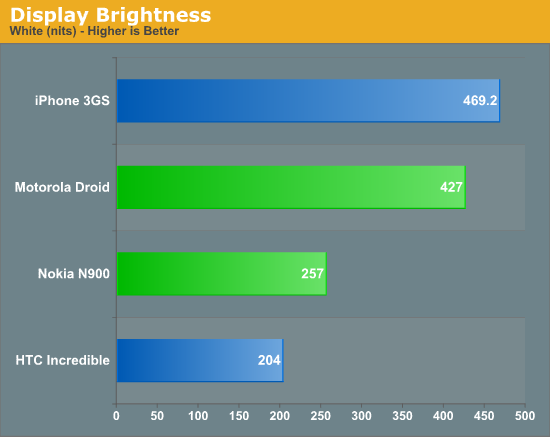

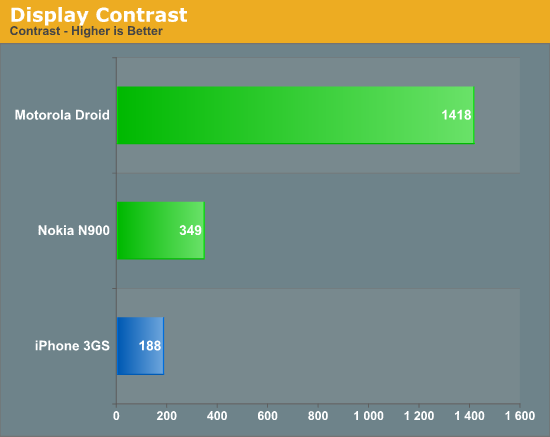
The HTC Droid Incredible is notably absent from the display contrast graph because contrast is... well... infinite in this circumstance. Or at least indeterminate. Whatever the case, AMOLED delivers the absolute best contrast possible. It's really amazing in person.
Outdoors, however, the N900 is an obvious winner - just look at the direct sunlight example down below. The AMOLED display on the Incredible is more difficult to read in indirect sunlight, and very challenging to look at in direct sunlight.
One last thing I'd like to note is that I've read in more than a few articles some claims that the AMOLED display is readable with polarized glasses - that there aren't any angles where there is complete extinction like with normal LCDs. This is false; rotate any AMOLED screen around, and brightness will still fall off following cosine squared like any other analyzing polarizer.


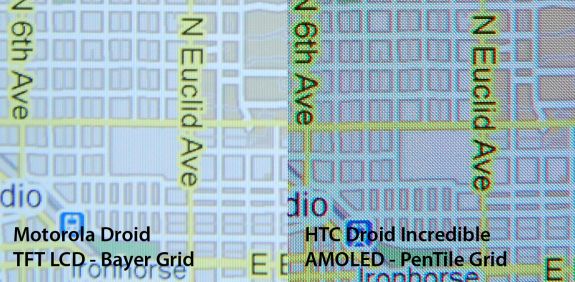
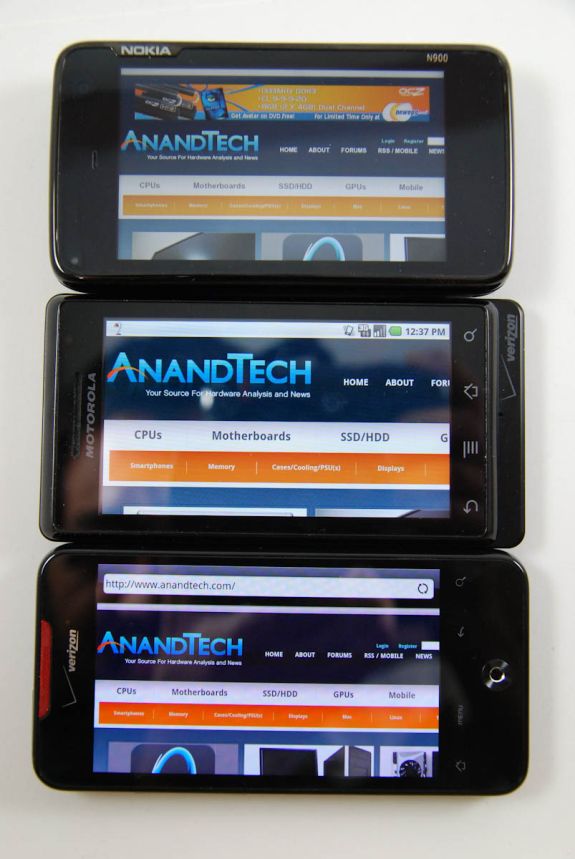
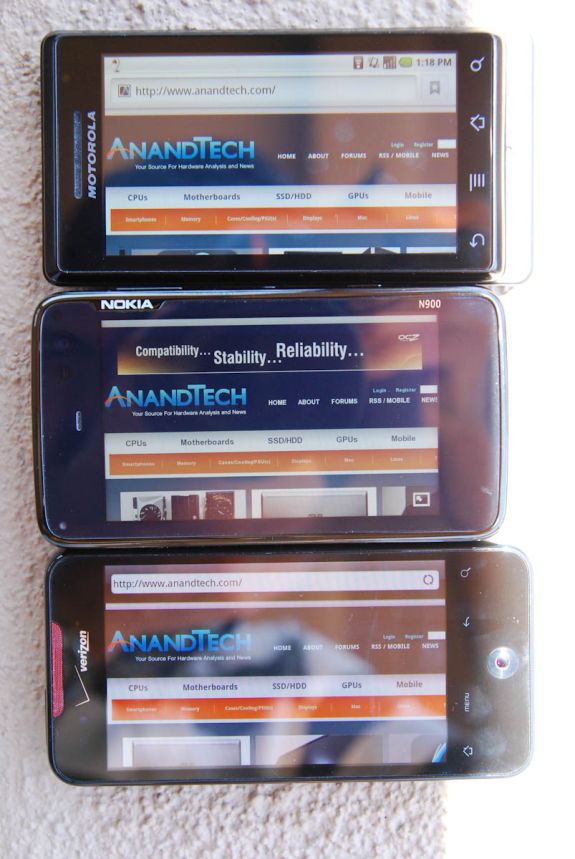
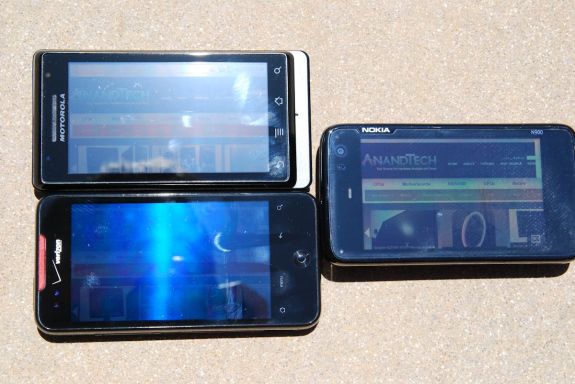








68 Comments
View All Comments
DaveGirard - Saturday, June 12, 2010 - link
sweet Jesus, that Nokia phone is huge. Does it double as an ice cream sandwich cover?metafor - Sunday, June 13, 2010 - link
Cortex is the CPU designed by ARM. This is available as a hard-macro (layout already done) or soft-macro (just the functional RTL). Some companies license this in either version. For those who license the soft-version, such as TI, nVidia and Broadcom, they can do a customized place-and-route along with clock-tree optimizations and voltage partitioning to try to make the design run faster.However, the micro-architecture is the same.
A few companies have ARM architectural licenses (Apple, Qualcomm, Marvell) and instead of licensing the Cortex line of processors, they design their own. The micro-architecture is developed independent of what ARM did in their Cortex series albeit there will often be similarities.
Scorpion inside Snapdragon was developed in the course of years and while it has many similarities to the A8 from a power-point standpoint, the micro-architecture underneath was designed from the ground up. Everything from the branch predictors, the cache controller, exception handling, execution units and most notably, a partially OoOE scheduler and retirement buffer.
There's also the 128-bit, fully pipelined, partially OoOE SIMD/FP unit.
medi01 - Sunday, June 13, 2010 - link
Well, I find it very strange, that "incidentally" iPhone is never shown in bad light. Could you please update your side to side comparison?Impulses - Wednesday, June 16, 2010 - link
Personally I think there's better things for you guys to do or test with your time... Who cares if a phone's screen colors are more or less accurate, as long as they aren't outright flawed or ugly to look at it shouldn't be a big deal, not like anyone's gonna be doing any pro content editing work on their phones! (I don't even own an AMOLED screen so I'm not particularly biased one way or the other, I own an EVO atm)mojtabaalemi - Saturday, June 19, 2010 - link
I hate the design of nokia mobile phones . in my idea an iphone is far far better !paihuaizhe - Sunday, June 20, 2010 - link
(nike-alliance).(com)=>is a leading worldwide wholesaler company (or u can sayorganization)
arnavvdesai - Saturday, June 26, 2010 - link
I was just wondering if the author had installed AdBlock+ and then run the browser speed numbers or without it being on. If it was not installed which is what I am guessing from the photos, did you notice an improvement in the render times when it was installed. I actually bought the phone recently after seeing it on sale for 380$ and wanted to know the details. Also, I have heard that the current build of the OS allows potrait mode even for the browser(although it has to be activate through some setting) and not just the phone.drwiremore - Sunday, July 4, 2010 - link
Amanda, delighted to have found you. Given the issues in the title, affecting 20~50% of MOTO Droid users, was surprised to see no mention of it. The MOTO boards are alive with disdain and some feel an in you face attitude by Motorola Droid 2 and X announcements. Would you do an iPhone like analysis of voice, antenna and signal issues across Verizons Droids: HTC incredible and MOTO Droid. Your scientific analysis would be welcomed.